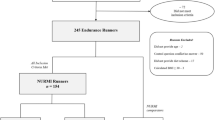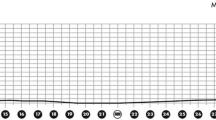Abstract
Purpose
This study attempted to clarify the relationships between marathon time and monthly training volume, training frequency and the longest (LRD) or average running distance per workout (ARD), as well as their interactions.
Methods
Male recreational runners (n = 587) participating in the Hokkaido Marathon 2017 completed a questionnaire before the race; of these, 494 finished the race. We assessed age, running career, body height, body weight, body mass index (BMI), monthly training volume, training frequency, the LRD and the ARD. These indicators were each divided into 4 or 5 homogeneous subgroups to determine whether the other indicators in each subgroup predicted marathon time.
Results
In the training frequency subgroups, there were significant correlations between monthly training volume, the LRD or the ARD and marathon time, except for the subgroup that trained 2 times per week or less; in this subgroup, the relationship between the ARD and marathon time was not significant. In all monthly training volume subgroups, there were no significant relationships between training frequency, the LRD or the ARD and marathon time. In the ≥ 21 km LRD and ≥ 10 km ARD subgroups, there were significant correlations between monthly training volume and marathon time (all P < 0.01); these correlations were not significant in the 1–20 km LRD and < 10 km ARD subgroups.
Conclusion
These results indicate that monthly training volume is the most important factor in predicting marathon time and that the influence of monthly training volume is only significant if the running distance per workout exceeded a certain level.
Similar content being viewed by others
Abbreviations
- ARD:
-
Average running distance per workout
- BMI:
-
Body mass index
- IQR:
-
Interquartile range
- LRD:
-
Longest running distance per workout
References
Barandun U, Knechtle B, Knechtle P et al (2012) Running speed during training and percent body fat predict race time in recreational male marathoners. Open Access J Sports Med 3:51–58
Dotan R, Rotstein A, Dlin R et al (1983) Relationships of marathon running to physiological, anthropometric and training indices. Eur J Appl Physiol 51:281–293
Fokkema T, van Damme AADN, Fornerod MWJ et al (2020) Training for a (half-)marathon: training volume and longest endurance run related to performance and running injuries. Scand J Med Sci Sports 30:1692–1704
Foster C (1983) VO2 max and training indices as determinants of competitive running performance. J Sports Sci 1:13–22
Foster C, Porcari JP, de Koning JJ et al (2012) Exercise training for performance and health. Dtsch Z Sportmed 3:69–74
Gordon D, Wightman S, Basevitch I et al (2017) Physiological and training characteristics of recreational marathon runners. Open Access J Sports Med 8:231–241
Hagan RD, Upton SJ, Duncan JJ et al (1987) Marathon performance in relation to maximal aerobic power and training indices in femal distance runners. Br J Sports Med 21:3–7
Haugen T, Sandbakk Ø, Siler S et al (2022) The training characteristics of world-class distance runners: an integration of scientific literature and results-proven practice. Sports Medicine- Open 8:46
Hikida RS, Staron RS, Hagerman FC et al (1983) Muscle fiber necrosis associated with human marathon runners. J Neurol Sci 59:185–203
Karp JR (2007) Training characteristics of qualifiers for the U.S. Olympic marathon trials. Int J Sports Physiol Perform 2:72–92
Keogh A, Sheridan OO, Mccaffrey O et al (2020) The determinants of marathon performance: an observational analysis of anthropometric, pre-race and in-race variables. Int J Exerc Sci 13:1132–1142
Knechtle B, Duff B, Welzel U et al (2009) Body mass and circumference of upper arm are associated with race performance in ultraendurance runners in a multistage race - the isarrun 2006. Res Q Exerc Sport 80:262–268
Knehtle B, Rüst CA, Rosemann T et al (2012) Estimation bias: body mass and body height in endurance athletes. Percept Mot Skills 115:833–844
Loflin M, Sothern M, Koss C et al (2007) Energy expenditure and influence of physiologic factors during marathon running. J Strength Cond Res 21:1188–1191
Macera CA, Pate RR, Powell KE et al (1989) Predicting lower-extremity injuries among habitual runners. Arc Intern Med 149:2565–2568
Marti B, Vader JP, Minder CE et al (1988) On the epidemiology of running injuries. the 1984 bern grand-prix study. Am J Sports Med 16:285–294
Nielsen RO, Buist I, Sørensen H et al (2012) Training errors and running related injuries: a systematic review. Int J Sports Phy Ther 7:58–75
Nikolaidis PT, Knechtle B (2017) Effect of age and performance on pacing of marathon runners. Open Access J Sports Med 8:171–180
Nikolaidis P, Knechtle B (2020) Validity of recreational marathon runners’ self-reported anthropometric data. Percept Mot Skills 127:1068–1078
Runnal Editorial Office (2022) Marathon time and monthly mileage guideline! What is the target for sub 3? What is the target for sub 4? What is the target for sub 5? https://runnal.com/8843 (in Japanese). Accessed 9 Aug 2022.
Rüst CA, Knechtle B, Knechtle P et al (2011) Predictor variables for a half marathon race time in recreational male runners. Open Access J Sports Med 2:113–119
Salinero JJ, Soriano M, Lara B et al (2017) Predicting race time in male amateur marathon runners. J Sports Med Phys Fitness 57:1169–1177
Takeshima N, Tanaka K (1995) Prediction of endurance running performance for middle-aged and older runners. Br J Sports Med 29:20–23
Tanda G (2011) Prediction of marathon performance time on the basis of training indices. J Hum Sport Exerc 6:511–520
Tanda G, Knechtle B (2013) Marathon performance in relation to body fat percentage and training indices in recreational male runners. Open Access J Sports Med 4:141–149
Tanda G, Knechtle B (2015) Effects of training and anthropometric factors on marathon and 100 km ultramarathon race performance. Open Access J Sports Med 6:129–136
Tomo run (2022) marathon-monthly-distance. https://tomo.run/marathon-monthly-distance (in Japanese). Accessed 9 Aug 2022.
Van Middelkoop M, Kolkman J, Van Ochten J et al (2008) Risk factors for lower extremity injuries among male marathon runners. Scand J Med Sci Sports 18:691–697
Warhol MJ, Siegel AJ, Evans WJ et al (1985) Skeletal muscle injury and repair in marathon runners after competition. Am J Pathol 118:331–339
Web Marketing Associates (2022) MarathonGuide. Com – International Marathons Races Directory and Schedule. http://www.marathonguide.com/races/races.cfm?place=Intl. Accessed 9 Aug 2022.
Wen DY, Puffer JC, Schmaizried TP (1998) Injuries in runners: a prospective study of alignment. Clin J Sports Med 8:187–194
Zillmann T, Knechtle B, Rüst CA et al (2013) Comparison of training and anthropometric characteristics between recreational male half-marathoners and marathoners. Chinese J Physiol 56:138–146
Acknowledgements
We wish to thank the volunteers of NPO Runners Support Hokkaido for their cooperation.
Funding
No funding was received to assist with the preparation of this manuscript.
Author information
Authors and Affiliations
Contributions
All authors contributed to the study conception and design. AY contributed to the interpretation of the results and the manuscript drafting. MS, AA and KI significantly contributed to data aggregation and analysis. TF developed the statistical analysis plan and interpretation. KS and IM substantially contributed to the manuscript drafting. All authors read and approved the final version of the manuscript.
Corresponding author
Ethics declarations
Conflict of interest
The authors have no competing interests to declare that are relevant to the content of this article.
Ethics approval
The questionnaire and methodology for this study was approved by the Ethics Committee of Health Sciences University of Hokkaido (approval number 16R036033).
Consent to participate
Informed consent was obtained from all individual participants included in the study.
Additional information
Communicated by Philip D. Chilibeck.
Publisher's Note
Springer Nature remains neutral with regard to jurisdictional claims in published maps and institutional affiliations.
Rights and permissions
Springer Nature or its licensor holds exclusive rights to this article under a publishing agreement with the author(s) or other rightsholder(s); author self-archiving of the accepted manuscript version of this article is solely governed by the terms of such publishing agreement and applicable law.
About this article
Cite this article
Yamaguchi, A., Shouji, M., Akizuki, A. et al. Interactions between monthly training volume, frequency and running distance per workout on marathon time. Eur J Appl Physiol 123, 135–141 (2023). https://doi.org/10.1007/s00421-022-05062-7
Received:
Accepted:
Published:
Issue Date:
DOI: https://doi.org/10.1007/s00421-022-05062-7




